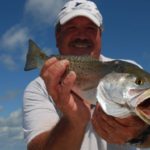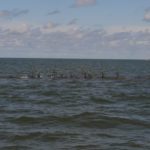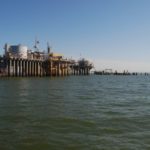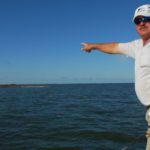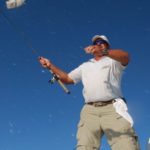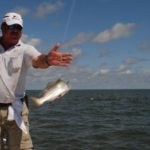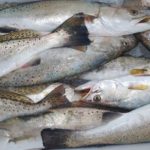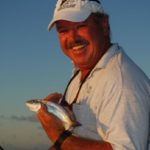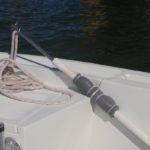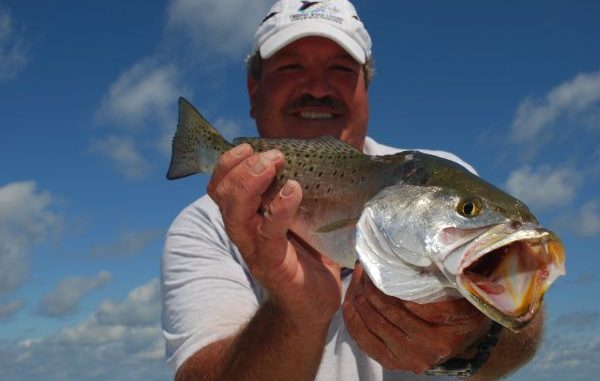
This area is eroding faster than Obama’s approval numbers, but it still produces a crazy amount of fish.
The smoke/glitter sparkle beetle arched through the air toward a handful of scraggly, brush sticks poking out of the water — the few remains of the live black mangroves that once covered a substantial island. Two feet into the retrieve, the lure stopped and the water erupted into a wild explosion of spray as the fish shook its head violently in an unsuccessful attempt to rid its yellow mouth of the stinging hook.
The big man on the bow expertly flipped the 2-pound fish into the boat. The huge smile that seemed to perpetually wreath John “Hawkeye” Aucoin’s broad face became even wider as he briefly admired the quicksilver flanks of the speckled trout before slipping it into the ice chest to join nearly 20 of its brethren.
The translucent emerald green water of Timbalier Bay was roofed by cloudless azure skies. The seasons of spring and fall in Louisiana offer up a handful of perfect days. This was one. The chill of the early morning air when we left the public boat launch in Golden Meadow disappeared as the sun warmed the air to the low 70s. And the professional guide, owner of Hawkeye Fishing Charters, found aggressively biting speckled trout.
It seemed like Eden. Life was good!
Or was it?
It was late transition time, that hard-to-define period that occurs in speckled trout fishing twice a year. Summer, when specks are actively feeding and spawning, finds the fish locked into high-salinity lower bays and the coastline. Winter will find concentrations of the fish well up in interior, low-salinity marshes. But in spring and fall, when the fish are shifting from one place to the other, finding them can be a challenge.
It was late April and Aucoin figured that the fish would be nearing the end of their movement toward their summertime haunts, so a long run from Golden Meadow to the south would be the order of the day. The run gave Aucoin time to deliver a requiem for the marshes of Lafourche Parish, as well as for the “good earth,” as Terrebonne translates from French.
He piloted the 27-foot welded-aluminum Gravois across Catfish Lake, then across Grand Bayou Blue and Little Gray Duck and Big Gray Duck bays en route to Lake Raccourci.
With dismay, Aucoin waved one arm over and over, pointing out land loss.
“Look at that,” he intoned. “That used to all be [marsh] grass.”
Finding a defined shoreline of a lake or bayou was difficult. There seemed to be areas of water with clumps of marsh grass scattered over it, and there seemed to be areas of water without grass clumps. The former were, in the not too distant past, almost solid meadows of chest-high grasses and sedges. Now they are what locals call “broken marsh.” Aucoin believes that soon they will be gone, leaving nothing but open water.
Although he still fills ice chests with speckled trout for his customers, he quickly admits that doing so is much harder than when the marsh was intact — and not because fewer fish exist. Rather, the fish that are in the system have so many more places to scatter to. What used to be marsh is now shallow water, difficult to navigate and fish.
Compounding the challenge, many formerly deep areas in lakes and especially bayous have filled in with the muck of the eroded marsh. These deep water spots held speckled trout in large numbers seasonally. These “aces in the hole” no longer exist as they once did.
The large areas of open, shallow water with bottoms composed of tiny, easy-to-suspend sediment particles very rapidly become muddy with almost any wind at all. And once in suspension, the fine particles may take days to settle enough to clear water to fishing conditions.
The sleek boat sliced on southward into Deep Lake, and then with no shoreline to signify a change, Aucoin announced that we had entered Lake Raccourci. It was just water, water and more water, with no lake shores or barriers. Near the lower end of the lake, the boat approached what the GPS map identified as Northwest Island, a significant splotch of land on the screen.
But the island was gone. The only trace of the island was a break of the pattern of waves caused by the shallow water on the crest of the former island and two white PVC pipes that someone stuck in place to mark the shallows.
He slowed the boat to a stop and peered at the spot. “Sick” is how he described his feelings.
“My kids will never see what I’ve seen,” he said. “It used to look like the Bahamas. All the islands had shell beaches on them. All the bays were divided by land.”
He circled the submerged island to approach it from what he calculated the best angle to be and made a few casts, but lost interest rapidly. He cranked up the boat and headed south again — destination Casse Tete Island. He was going to have to stop to fish soon. South of Casse-tete Island lay only Calumet Island and then East Timbalier Island before the waters of the open Gulf of Mexico.
Aucoin stopped the boat to fish a lonesome football field-sized island crowned with gnarly black mangroves. The island was crowded with pelicans and if it would have been any smaller, the birds would have had to stand on each other’s backs. He jockeyed the trolling motor to take the boat around the island, peppering its edges with casts of his smoke/glitter beetle.
His rifleshot casts were, whenever possible, toward targets. Any sign of a mullet invited a cast. The same with slicks, oily spots that appear on top of the water. Aucoin explained that he likes slicks that have just popped up because the fish are likely very close to the slick their feeding activity produced. Wind and current move older slicks away from the feeding activity, making the feeding fish difficult to locate.
He added that not all slicks are made by trout. Redfish and even catfish produce feeding slicks as well.
A couple of times, while circling the island, Aucoin replaced the plastic beetle on his jig head with a live cocaho minnow. But the change produced no positive results, beyond the two modest-sized specks he already had. So he picked up and headed south.
Casse-tete Island, a huge continuous chunk of land on Aucoin’s GPS map, appeared in front of the boat as a necklace of fragmented and tattered islands. A lot had changed in the five years since he bought the GPS. The tracks of his previous trips to the island showed the boat had traveled over what should have been solid land. A newcomer to the area would be bewildered, but Aucoin said that the 5-year old chip is an advantage.
“It shows me where islands used to be and where there is still a hump off the bottom,” he said. “Anything different will hold fish.”
Aucoin approached the island from its upwind side, as he did every spot during the day.
“Fish are spookier on the calm side,” he explained. “The minute you make a ripple, they know something is up.”
He quickly picked up a beautiful 2½-pounder on plastic.
“He liked that smoke beetle; he nailed it,” he grunted.
A couple of casts later, his quick eyes (His momma didn’t name him Hawkeye for nothing) spied a boat off in the distance, angling to the southwest.
“It looks like its heading to Brush Island,” he said as he quickly picked up the trolling motor. He was intent on beating the boat to the spot he later explained he had been itching to try all morning. He suspected that the water would be cleaner.
And it was — it was beautiful. And the other boat kept on going, in the direction of Timbalier Island. The condition of Brush Island, a sizable crescent over 2 miles long on the map, was dismaying. It was just a chain of shell-laden shadows of islands.
But conditions were indeed right. A school of baitfish off one end of the island piece he stopped at created a patch of shimmer, almost shivering surface water, “nervous water,” he called it, licking his chops. Sporadically, the water’s surface erupted in showering spray as a predator fish dashed in to grab a small fish.
The nervous water produced no trout, but the next piece he stopped at did — speck after speck, most of them beautiful fish that anyone would be proud to box up — 1½ to 2 pounds. Every cast seemed to produce a fish. If the first hit didn’t hook up, the next would.
Slicks bloomed around the boat, and the faint smell of watermelon perfumed the air. He set the hook hard. Every hookset sounded like a saber-swoosh in the air.
It was beautiful!
But it wasn’t. The spot he was catching the fish from was nothing more than a scraggly line of dead sticks protruding from the water, a skeleton of the crest of island. It wasn’t hard to realize that soon, even those bones would be gone. Next year’s transition fishermen would have a hard time finding this spot.
He spoke little about his beloved marshes on the way in, but a quiet comment made earlier in a Cajun accent thick as fudge divulged his feelings.
“When I retire from fishing, I’m going to retire to the woods of Mississippi,” he said. “I love the woods.”
Capt. John Aucoin is a featured angler in the upcoming book, Trout Masters Too: How The Pros Do It.
